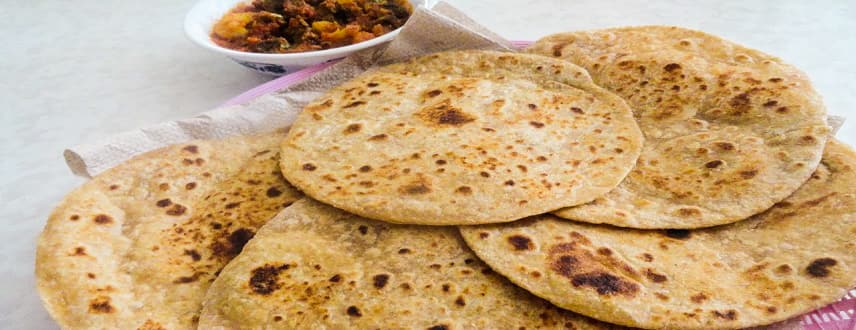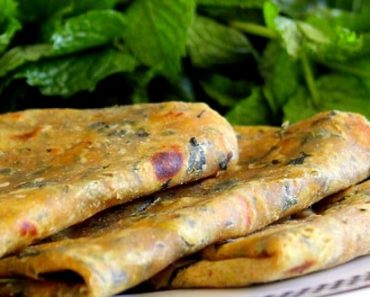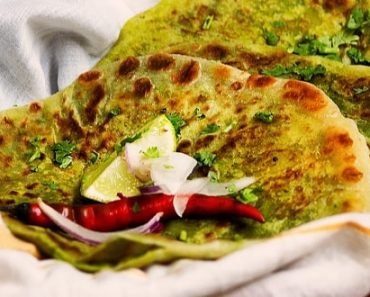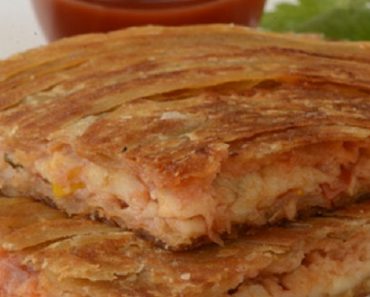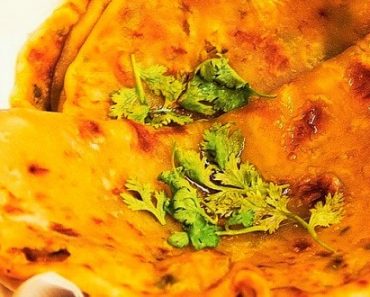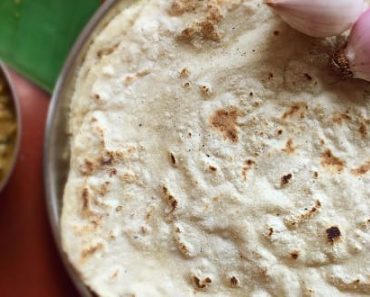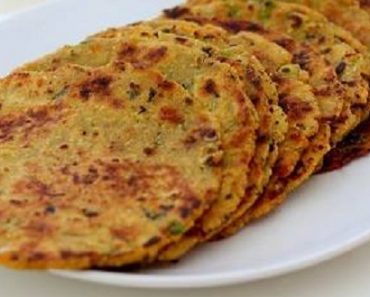The paratha is the popular Indian bread which is the staple food in many households. The plain paratha is a well-known type of unleavened flatbread which is made only from whole wheat flour. The preparation for the paratha recipe is very handy and needs few basic ingredients. This is a very tasty and healthy dish from the Indian Cuisine which you can have for breakfast, lunch or dinner.
Get Daily Dose of Delicious Recipes… Subscribe Now!
To make the plain paratha, all you need is the fresh whole wheat flour, also known as Atta. It is a bit salty in taste and has a little soft texture. The paratha can be rolled into interesting shapes and various sizes. The shape of paratha can be circular, triangular or square. Each method has its own technique to roll the paratha. In whichever shape you roll them, they would taste fantastic and smell fabulous. Yet, there will be a minor difference that the round shaped paratha will not be flaky like other two.
The flakiness in paratha is due to the spreading of the oil while you are folding the paratha. While you roll the paratha in triangular or square form, you need to apply some oil or ghee over the folds. Thus, these shaped paratha’s have flakiness in the texture along with the softness. The yummy paratha is generally either triangular or square shaped. But if you finding folding the paratha tough, then you can make simple circular paratha.
The plain paratha is the delicious Indianan flat bread with only Atta as the main ingredient along with water, oil and salt required to knead the dough. But, there are various types of Punjabi paratha which you can prepare at home with different stuffing. All these parathas are protein packed and make a wholesome meal. However, the basic plain paratha wins over the others. It is easy to roll the roast the plain paratha. If you are a novice in cooking, then you must begin with plain paratha.
Remarks:
- If the paratha dough looks dry, then you must add some water.
- If the paratha dough is too sticky or moist, then add some flour.
- Ghee enhances the taste of the paratha. I recommend you to use Patanjali Cow Ghee.
- The addition of ghee or oil helps to makes the paratha soft.
- Whether you use oil or ghee, there will be no change in the texture of paratha.
- Paratha’s won’t be soft and flaky if you make them on the non-stick frying pan.
- Always roast the paratha on the high-flame. Avoid roasting them on low-flame.
- The triangle shaped three later paratha are called as “POLI” in Maharashtra.
- The leftover Paratha dough can be stored in the fridge. You can re-use it next day.
- You can also use all-purpose flour or chapatti flour to make the paratha dough.
Garnish Idea:
The strong aroma of the ghee spreads all over the kitchen when you are roasting the paratha. This smell is very tempting and can easily catch anyone’s attention. But with the proper plating of the paratha, you can make them look appealing. Below mentioned are the few options or ideas for garnishing the paratha. You can garnish the paratha with:
- Keep tiny cubes of butter.
- Grate any of your favourite cheese.
- Keep the fried green chillies.
- Keep some mint leaves.
- Keep few coriander leaves.
- Keep dice chopped tomatoes.
- Keep onions rings.
- Drizzle some chutney.
- Sprinkle some red chilli powder.
Serving Suggestion:
- You can eat plain paratha without any side accompaniment.
- Serve with an extra drizzle of ghee.
- Spread some butter over the paratha before serving.
- You can eat with the paratha with any rich gravy dish.
- Paratha also goes well with any tangy and sweet pickle.
- You can have paratha with a cup of hot masala tea or coffee.
- Some people like to dip paratha in spicy or sweet or tangy chutney.
- You can also enjoy eating them with sweetened curd.
- The warm paratha can be eaten with a curry based dish.
- Even tomato chutney or the tomato ketchup goes well with the hot paratha.
- This classic Indian flattened bread can be served with all Indian vegetable dishes.
- It can be with any vegetable curry or any dry vegetable dish.
- At times, the plain parathas are served with honey.
- The shallow fried paratha can be eaten with the soup as well.
- The most popular combination of butter paratha is with:
The best is to just eat a paratha plain with a little butter, yogurt or pickle. Serve hot paratha with any type of curry, dals or chutneys.
Quick Tip:
- You can roast paratha in oil or butter as well.
- You can skip adding ghee or oil in the dough of paratha. (But then they won’t be soft.)
- Roasting the paratha on the low-flame can make them hard.
- For the little variation, you can add homemade Dahi or milk in the dough.
- You may add some cumin seeds in the paratha dough for refreshing flavours.
- You can also use lukewarm water to knead the dough.
- For all the newbies, it is suggested to make the paratha in the circular shape.
- To make paratha, you can either only Maida (all-purpose flour) as well.
- For those making paratha first time, you can roll all balls into paratha first. And then cook the paratha one by one.
- Make paratha in oil if you are living in cold climate. The ghee will harden the paratha.
These plain paratha’s are also popularly known as tava paratha. It is because they are cooked on tava. Though the preparation is almost same, yet every hour as its own way of cooking paratha. This Indian unleavened bread is very common and popular in each family. Every member in the family have different favourite paratha. Though the paratha is basically Indian bread made with whole wheat Atta but you can also prepare stuffed paratha’s. You can make plain paratha, spiced paratha or stuffed paratha. You can use all types of spice powders, whole spices, fresh veggies, homemade paneer or even grated cheese to make paratha. The green seasonal veggies give vibrant green colour to healthy paratha.
Plain paratha’s are usually layered and are served with Dal or gravy. The combo of paratha with curry make a complete meal which is very filling and tasty. These easy and quick Plain Paratha Recipe is often the best when you are in hurry. The paratha’s are often prepared for breakfast, and leftover can be refrigerated or packed for as a tiffin box. They go well with pickle or chutney. The plain paratha can go good even for the mid-day meal or can be eaten with evening tea. These healthy paratha’s can be packed for lunch box and tiffin’s as well.
What is difference between Paratha, Nan and Roti?
Many people get confused between paratha, Nan and roti. All these things are mad with whole wheat flour but paratha’s are the unleavened Indian flat bread. Though the dough for all these three different varieties is same but still there is difference in the texture. The paratha is bit thinner than Nan, but is thicker than Roti. Also, the paratha’s are crisper and flakier than the phulkas or roti. They are traditionally cooked in ghee and over the tava.
Whereas the Nan is cooked in butter and roti can be prepared in oil. The Paratha’s are relatively quick to make than Nans or Tandoori Roti. The paratha are also a healthy substitute for Nan. You can experience the difference only when you try the paratha recipe. Although roti, paratha and Nan are made with pretty much the same ingredients, there is difference in the preparation method.
The style of rolling the paratha is slightly different and complex than roti or Nan. The method of cooking the paratha also varies a bit. Even the medium of cooking the paratha is different. The paratha can be cooked with or without oil, the choice is based on personal preference. So though the dough and ingredients are similar, there is difference flavour and texture of paratha.
How to roll spiral shaped paratha?
You can also roll the paratha into the spiral shape. In this another way of making paratha, you have to take a small ball of dough and spread it on rolling board. Then apply some ghee. Now, to prepare the spiral shaped paratha, roll out and apply butter on the surface. Dust some flour and roll the paratha into a cylinder shaped or fold it alternately.
To make spiral shaped paratha, follow these steps:
- Apply flour on a clean surface.
- Dust the flour lightly on the rolling area.
- Divide the dough into equal sized balls.
- Roll each ball out into a circle.
- Keep the diameter about 5-6”.
- Now, roll it like a cylinder.
- You have to roll in the shaped of the cylindrical structure.
- Now roll the cylinder into a spiral.
- Coil this cylinder into a spiral.
- It would look like a blob.
- Once again roll it horizontally into a spiral ball shape.
- Keep it aside for 5 minutes.
- Very gently roll out the spiral into a flat circle.
With all the remaining dough, you have to repeat the same process. Once you prepared the paratha with the spiral rolls, then keep the tava on stove. If you want more than one layer in paratha, then you can repeat the process 4 to 5 times. Apply ghee on tava and heat it. Pan fry the paratha in hot tava. Cook and apply some ghee on both sides. Wait till the paratha are golden.
How to keep paratha soft?
To keep your paratha’s soft, follow these tips and tricks:
- You must keep them covered.
- You can place kitchen tissues over them.
- You can keep the clean cloth on the paratha.
- You can store the cooked paratha in casserole.
- You can also keep the paratha in the roti basket.
- Place a cloth in a box and stack the paratha.
- Keep them covered with the kitchen napkin in the plate.
- Do not fry the paratha on a low flame.
- You can also use milk instead of water.
- You can add curd while preparing the dough.
How to Store Paratha?
If you want to enjoy eating the paratha, then it is very important that they stay soft. So, if you are unable to consume the paratha immediately as they are cooked or if you cannot eat them after making it, then you must store them properly.
When the paratha’s are warm, immediately wrap them in soft cotton cloth. You must use a clean and neat cloth for this. It is better to keep a separate and a new washed handkerchief. After wrapping, you can keep the stack of paratha in a stainless steel box. You may even use tiffin box or casserole.
With the proper storage of paratha, they can stay soft and edible for 3-4 hours.
How do you make paratha?
To make the paratha at home, you have to make the paratha dough with flour and ghee. Add water and salt as required. Knead the dough and let it rest. Roll the dough into paratha and then heat the griddle. Keep your rolled dough over it and apply some ghee. Cook the paratha and flip it when you see the tiny bubbles. As one surface is cooked, turn again and apply ghee. This way fry or roast the paratha on the griddle or tava. When both sides are crispy and golden brown, you can take paratha to plate.
What is paratha made out of?
The paratha are made of various types. The plain paratha is the basic of all and it is made with the wheat flour only. The ghee is added to make the paratha soft. You need water to knead the dough and salt will balance the flavours.
If you are making any other type of paratha apart from plain, then there will be addition in ingredients. But the flour, water, ghee and salt are going to remain in all the paratha dough. The ingredients are added based on which type of paratha you want to it.
Variation to Plain Paratha:
For the expert in cooking, the plain paratha can be the base to try out new experiments with paratha. You can even twist with the traditional way of preparing paratha at home. You may add a pinch of cumin and change the whole taste of the paratha. You can use carom seeds and make whole new type of paratha. From the basic paratha recipe, transform it to your customized recipe.
The plain paratha is the basic and the most ordinary among various paratha’s. Yet, there are many other simple and easy everyday paratha’s which you can try at home. The only thing is to get the get the correct technique of making paratha down. Once you master it, then you can get really creative.
If you know how to make basic paratha, then you can learn how to make different varieties of paratha. These variations are also easy, and quick. You just have to prepare stuffing of your choice an fill it in the paratha, then roll it.
You can use any ingredient of your choice. You may use ajwain to make ajwain paratha. Yu can add grated vegetables or grated cheese. To make paratha healthier, you can use zucchini or cabbage in the preparation of paratha dough. Also, you can add chopped spinach or kale. Even the green peas can also be used in the dough. The best of all the variation is to stuff the paratha with a spicy mashed potato mixture. This makes delicious Aloo paratha which are highly tummy-filling.
The variations in paratha and combination of ingredients are really endless. The way to make the paratha remain same for any type, but the only change is in the list of ingredients. Check below for some different type of paratha other than plain paratha.
Masala Paratha Recipe:
If you are bored of having the plain paratha, then it is a nice and spicy variation. This Masala paratha is very much similar to the basic paratha with only difference of some spice powders. These masalas are added to give punch of some flavours and spicy zest. With below mentioned spice powders and other ingredients, prepare the dough. Roll the paratha and roast it.
The List of Ingredients: Whole Wheat Flour (Chapatti Atta), Red Chili Powder, Turmeric Powder, Garam Masala, Coriander Powder, Cumin Seeds, Carom Seeds, Cilantro, Salt, Oil and Water.
Cheese Paratha
For all the cheese lovers, this is one type of paratha which you would not want to miss. The paratha stuffed with cheese is a treat for taste buds. It is tasty, healthy and highly tummy-filling. This wholesome paratha are fully protein packed and nutritious. (Learn to make Cheese Paratha.)
The List of Ingredients: Whole Wheat Flour (Chapatti Atta), Cheese, Black Pepper Powder, Coriander Leaves, Green Chillies, Carom Seeds, Salt, Oil and Water.
Aloo Paratha:
It is very easy to prepare the Punjabi Aloo paratha at home. It is made with the most basic ingredients available in the kitchen. This recipe uses ingredients that are found in every Indian kitchen. Whether you are an expert or a newbie, this Aloo paratha can be made with ease.
The List of Ingredients: Wheat Flour, Potatoes(boiled and mashed), Coriander Leaves, Lemon Juice, Sugar, Red Chilli Powder, Green Chilli, Garam Masala, Grated Ginger, Oil, Butter, Salt, and Water.
Peas Paratha
If you love to eat peas and make your food health valuable, then this pea paratha is for you. The core ingredient is the green peas, whether fresh or frozen. With rest of the side ingredients you can add or skip as per you choice. Its preparation is simple and similar to other paratha’s. So, you can easily make peas paratha at home with handful of ingredients.
The List of Ingredients: Wheat Flour, Green Peas, Green Chillies, Coriander Leaves, Lemon Juice, Cumin, Ginger, Garlic, Garam Masala Powder, Oil, Butter, Salt, and Water.
Onion Paratha:
If you are tired of eating plain paratha all the time, then you can try to make Onion Paratha. It is not like usual stuffed paratha, but the dough itself is made with the chopped onions. It is easier, simpler and quicker when compared with other paratha’s. It is very tasty and very healthy.
The List of Ingredients: Wheat Flour, Onions, Cumin Seeds, Green Chillies, Garam Masala Powder, Coriander Powder, Coriander Leaves, Oil, Salt, and Water.

